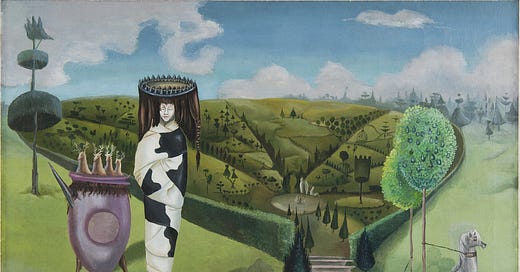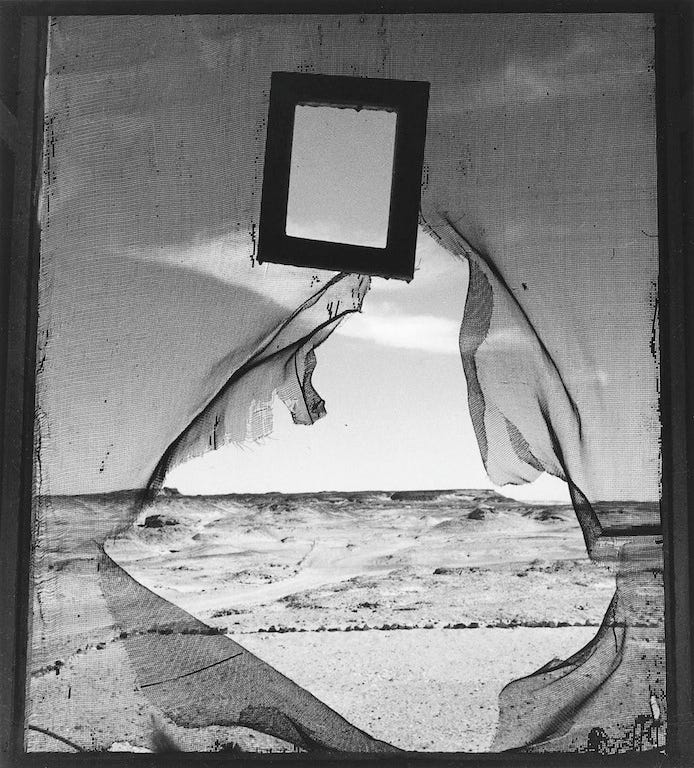A chapter from The Story of Art Without Men
Less than one week until my book hits the shelves in the US. Here's a preview!
Dear Readers,
It’s less than one week until The Story of Art Without Men publishes in the US. We’ve planned a very exciting Stateside Book Tour (think NYC, Boston, Philadelphia, LA, SF, an online talk for Substack subscribers, and more!). Want in? Preorder from Barnes & Noble for 25% off.
To get in the mood, I wanted to share with you a section from one of my favourite chapters: Surrealism. Think Lee Miller to Leonor Fini, Dora Maar and Leonora Carrington. These women were trailblazers.
Enjoy! Katy Xoxo
‘Of course the women were important, but it was because they were our muses. They weren’t artists’ – so claimed Roland Penrose, husband of Lee Miller, to legendary feminist Whitney Chadwick, during her visit to his home in the 1980s. When Chadwick later asked artist Leonora Carrington for her thoughts on the Surrealist muse, she replied, ‘I thought it was bullshit. I didn’t have time to be anyone’s muse ... I was too busy rebelling against my family and learning to be an artist.’
Building on the anti-establishment notions of Dada, in the wake of the political crises and traumas of the First World War, the Spanish Civil War, and the fear of encroaching fascism across Europe, the artists, writers and thinkers of the Surrealist movement rejected ideas of conventionality and were drawn to the subconscious. They placed emphasis on the power of dreams and the dislocated imagery found in their fantasies or nightmares, engaging in the brutality of the body, in part influenced by the return of missing-limbed veterans from the front lines. Using new methods of working, from Automatism (creating ‘without conscious thought’), which derived from Spiritualism, to collage and photo- montage, the Surrealists combined pictures of the real world with those in the depths of our minds.
Founded by poet André Breton in Paris in 1924, Surrealism was initially appealing to women due to its projected ethos of equality and radical and progressive thought. However, this was not entirely borne out in practice, and many women eventually rejected Breton due to his profound misogyny. For him, as he wrote in his 1929 manifesto, ‘The problem of woman’ was ‘the most marvellous and disturbing problem in all the world’. Given his views of women as muses, wonders, enigmas, objects and ‘femmes enfants’ (the childwoman was young, beautiful and obedient), it is not surprising that the female Surrealists had to carve out their own independent path, both through their art and the ways in which they dressed.
For male artists, Surrealist ideas were built around the sexuality of the female image, with the likes of Max Ernst and Salvador Dalí filling their canvases with violent and brutal images of fragmented or idealised bodies. However, as Carrington’s punchy ‘bullshit’ statement informs us, being seen as a muse was not something these strong-willed women intended to settle for, despite the gatekeepers of art history so often writing it that way.
Women’s role in Surrealism is a powerful, inventive and fascinating one. They switched up the eroticised portrayal of their own bodies by turning their gaze back onto themselves. They looked to represent liberation and oppression, imagination and transformation, as well as magical and sensual qualities in their work. In their depictions of dreamscapes, landscapes and frequently claustrophobic architectural interiors, they showed women as strong, dominating and free.
Unlike their male counterparts, who largely wore ‘three-piece tweed suits’, female Surrealists used dress as a means of expression, as if to become walking embodiments of Surrealist ideas, featuring themselves as animals, sphinxes and other mythological creatures (Leonor Fini would even dress up in lion-like headscarves!).
Centred mostly in Paris during the avant-garde, by 1930 the movement had attracted artists internationally – from runaway English debutantes (Carrington) to small-town American photographers (Miller). But although we hear so often about the male contribution to the movement, it was the women, working across collage, painting, photography, photomontage and sculpture, who also advanced Surrealist thinking and pushed forward techniques in the most radical of ways.
One of the leading Surrealist figures working in photography and photomontage was Dora Maar (1907–1997). Born Henriette Théodora Markovitch to a bourgeois family, Maar was raised be- tween Buenos Aires and Paris. Here she turned to photography after studying the decorative arts and painting, and captured the spirit of the movement through her gothic-inspired images.
Working both on commissions and on a commercial basis, Maar was one of the first women photographers to co-run a studio in Paris, and thrived in both her artistic and advertisement work. With the 1920s and 30s marking an exciting moment for commercial photography, thanks to the boom of advertising, magazine editors and contemporary brands favoured commissioning inventive photo- graphs over hand-drawn illustrations. And it was Maar’s distinctive eye and knowledge of Surrealist techniques that earned her work from a myriad of health and beauty projects designed to promote the ‘New Woman’. These included Femme aux cheveaux avec savon (Woman’s Hair with Soap), 1934, a shampoo promotion which depicted a highly imaginative and uncanny still of a woman washing her sculpture-like hair, and The Years Lie in Wait for You, c.1935, a photomontage of her friend, the poet Nusch Éluard, with a spider’s web superimposed over her face, created as marketing for an anti-ageing cream.

However, despite Maar’s eagerness to project the idea of a ‘modern woman’ – and many of the other women Surrealists’ intentions to do this – France between the two world wars was a ‘contradictory’ environment for women’s rights, with the state demanding women return to the home (and it wasn’t until 1944 that they were finally granted the right to vote). But like so many of her Surrealist contemporaries, she remained unmoved by the establishment. Motivated by her strong leftist beliefs, she ventured to the outskirts of Paris, London and Barcelona with a hand-held camera (very rare for a woman at that time) and captured subjects ranging from pearly queens to butchers and blind street peddlers in images now considered some of the earliest examples of ‘street photography’. Maar always saw the extraordinary in the mundane, even though she often infused it with a slightly strange, slightly gothic, uncanny atmosphere.
Maar’s friend and contemporary Lee Miller (1907–77) also worked on a range of subjects with varied photographic styles. Whether commercial, fashion or war photography, Miller always caught an image with an otherworldly atmosphere, and contributed to inventing techniques such as solarisation (exposing undeveloped images to the light to create a mystical, silvery effect) that would not only push forward the movement of Surrealism, but develop the practice of photography itself.
Born Elizabeth Miller in Poughkeepsie, New York, the young, fearless and highly intelligent Miller grew up being treated as an equal to her two brothers, with whom she was known to be fiercely competitive. However, when her mother became unwell and left her in the care of family friends at the age of seven, she was raped and contracted gonorrhoea. She was told never to speak of the incident. Miller moved to New York in her teens where she became a successful model, gracing the cover of Vogue after allegedly meet- ing Condé Nast himself at a road crossing.Ambitious and determined, Miller soon abandoned modelling to go behind the camera, travelling to Europe, where she assisted and collaborated with Man Ray. She was adept at finding Surrealist shapes within the body and rejected the male objectification of women entirely. Having been the muse and object for much of Man Ray’s work (in 1933, the year after she’d left for New York, he remade his work Object to Be Destroyed, 1923, by attaching an image of her eye to a metronome), it was through photography that Miller documented the suffocating reality of what it was like to be a woman in the 1930s, as seen in the image of her friend Tanja Ramm’s head suspended in a bell jar, silent and trophy-like.
A successful commercial photographer, Miller returned to New York in 1932, at the height of the Great Depression, and opened up a photographic studio under the androgynous name of ‘Lee’. Life then took her to Egypt, where, with her Surrealist lens, she photo- graphed expansive, empty desert scenes, glimpsed through a ripped mesh sheath, as seen in Portrait of Space, 1937. But it was in England that she settled, on the outbreak of global conflict, becoming a war correspondent for Vogue. Her photographs are records of women’s contributions to the war effort, but also of the grief-stricken mothers affected by loss. Reporting from Dachau and Buchenwald concentration camps, Miller famously captured the horrors experienced by so many.
To read more, preorder your copy of The Story of Art Without Men, and join us on the US Book Tour. (The book is out in the UK, Germany, France, Italy, Spain — more regions added soon!)
Thank you for reading this Substack. If you think someone else might enjoy this too, please share this article. If you have any feedback, please comment below.











Bought the Book.
Time to visit Canada !
Excellent!